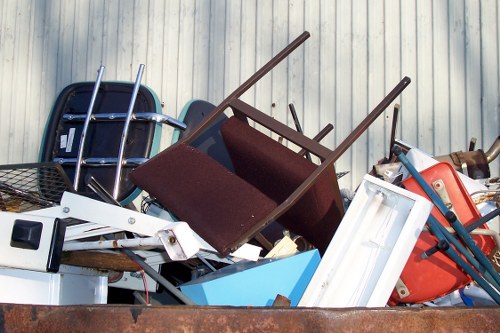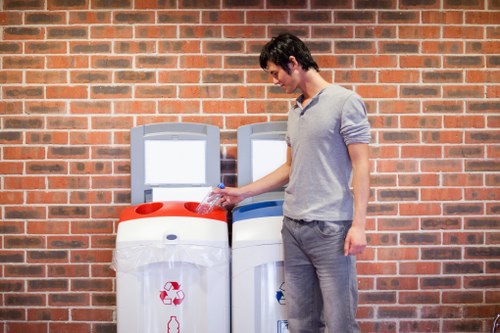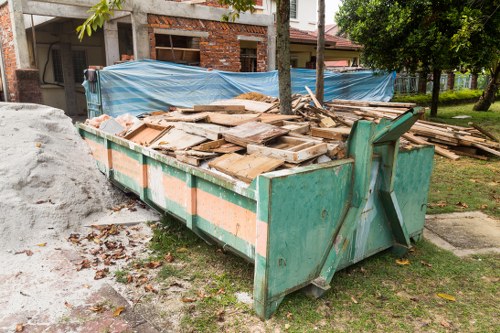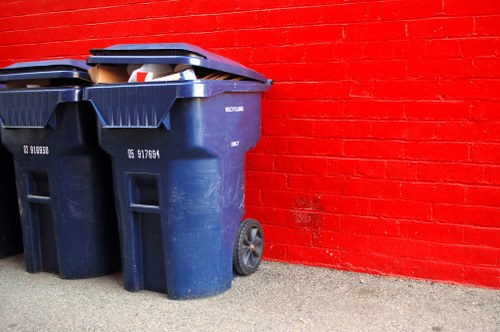Builders Waste Clearance in Chingford: Your Comprehensive Guide
Introduction to Builders Waste Clearance

When undertaking a construction or renovation project in Chingford, managing the waste generated is crucial. Effective builders waste clearance ensures a clean and safe environment, complies with local regulations, and promotes sustainability.
Builders waste can include a variety of materials such as concrete, bricks, wood, metal, and plasterboard. Proper disposal and recycling of these materials not only reduces environmental impact but also helps in maintaining the aesthetics and functionality of the workspace.
In this guide, we will explore the essentials of builders waste clearance in Chingford, offering insights into best practices, local regulations, and tips for choosing the right clearance service.
Why Proper Waste Clearance Matters

Proper waste clearance is more than just tidying up after a project. It plays a significant role in ensuring safety, environmental sustainability, and compliance with legal requirements.
Safety: Accumulated waste can pose serious safety hazards, including risks of accidents, injuries, and fire hazards. Clearing waste promptly helps maintain a secure working environment for both workers and residents.
Environmental Impact: Many building materials are recyclable or reusable. By appropriately segregating and disposing of waste, you minimize the environmental footprint of your project, contributing to a greener Chingford.
Types of Builders Waste

Understanding the different types of waste generated during building projects is essential for effective clearance and recycling.
Common Builders Waste Materials
- Concrete and Bricks: Often require special handling and recycling methods.
- Timber and Wood: Can be reused or repurposed if not treated with harmful chemicals.
- Metal: Highly recyclable, including aluminum, steel, and copper.
- Plasterboard: Must be disposed of properly to prevent environmental contamination.
- Tile and Marble: Heavy and may need specialized transportation and recycling solutions.
Hazardous Waste
Some building materials may be classified as hazardous waste, requiring careful handling and disposal. These can include asbestos, paints, solvents, and certain electronic components.
Regulations for Hazardous Waste
Chingford has strict regulations regarding the disposal of hazardous waste. It is imperative to work with clearance services that are licensed and experienced in handling such materials.
Local Regulations and Compliance

Adhering to local regulations for waste clearance is not only a legal obligation but also a best practice for responsible construction.
Chingford Waste Management Policies
- Licensing: Clearance services must be licensed to handle and dispose of various types of waste.
- Segregation: Waste must be sorted into categories for recycling, reuse, or safe disposal.
- Documentation: Proper records of waste disposal are required to ensure compliance and transparency.
- Environmental Protection: Measures must be in place to prevent pollution and promote recycling.
Penalties for Non-Compliance
Failing to comply with waste clearance regulations in Chingford can result in hefty fines, project delays, and damage to your reputation. It is crucial to partner with reputable clearance services that prioritize compliance.
Choosing the Right Builders Waste Clearance Service

Selecting a reliable waste clearance service in Chingford is vital for the smooth progression of your project. Here are key factors to consider:
Experience and Expertise
Choose a service provider with extensive experience in builders waste clearance. Their expertise ensures efficient handling, sorting, and disposal of various waste types.
Comprehensive Services
Opt for companies that offer a full range of services, including waste collection, transportation, recycling, and disposal. Comprehensive services save time and simplify the clearance process.
Customer Reviews and Reputation
Check customer testimonials and reviews to gauge the reliability and quality of the service provider. A strong reputation indicates consistent performance and customer satisfaction.
Competitive Pricing
Compare pricing among different clearance services to ensure you receive value for money. Transparent pricing models without hidden fees are preferable.
Eco-Friendly Practices
Choose services that prioritize recycling and environmentally friendly disposal methods. Sustainable practices contribute to a healthier community and environment.
Availability and Flexibility
Ensure the clearance service can accommodate your project timeline and offers flexible scheduling options to meet your needs.
Best Practices for Builders Waste Clearance

Implementing best practices in waste clearance can enhance efficiency, reduce costs, and minimize environmental impact.
Planning and Scheduling
Develop a waste management plan before starting your project. Schedule regular clearance intervals to prevent accumulation and ensure a continuous workflow.
Waste Segregation
Separate waste into different categories on-site. This makes the sorting process easier and increases the chances of recycling and reuse.
- Recycle: Metals, wood, and concrete.
- Reuse: Materials like timber and bricks that are in good condition.
- Dispose: Hazardous materials requiring special handling.
Safe Handling Practices
Ensure all workers are trained in safe waste handling procedures. Proper handling reduces the risk of accidents and environmental contamination.
Protective Gear
Provide appropriate protective equipment to workers handling waste, especially hazardous materials. Safety should always be a top priority.
Regular Monitoring and Evaluation
Continuously monitor waste generation and clearance processes. Evaluate the effectiveness of your waste management plan and make necessary adjustments.
Continuous Improvement
Seek feedback from workers and stakeholders to identify areas for improvement. Implementing changes based on feedback can enhance overall efficiency.
Cost Factors in Builders Waste Clearance

Understanding the cost factors involved in builders waste clearance helps in budgeting and selecting the right service provider.
Volume of Waste
The amount of waste generated directly impacts the cost. Larger projects produce more waste, requiring more resources for clearance.
Type of Waste
Different waste types have varying disposal costs. Hazardous materials typically incur higher fees due to the need for specialized handling.
Service Frequency
Frequent clearance services may offer discounts or more flexible pricing options. Regular clearance can prevent waste buildup and reduce overall costs.
Transportation Costs
The distance between the site and disposal facilities affects transportation costs. Choosing a local clearance service can minimize these expenses.
Additional Services
Additional services such as on-site sorting, recycling, and emergency clearance may come at an extra cost. Evaluate which services are necessary for your project.
Long-Term Savings
Investing in efficient waste clearance can lead to long-term savings by reducing project delays and promoting the reuse of materials.
Sustainability in Builders Waste Clearance

Sustainability is a growing concern in the construction industry. Implementing eco-friendly waste clearance practices contributes to environmental preservation and social responsibility.
Recycling and Reuse
Promote recycling and reuse of materials wherever possible. Partner with clearance services that prioritize these practices to minimize landfill waste.
Energy-Efficient Disposal Methods
Choose methods that reduce energy consumption and lower the carbon footprint of waste clearance operations. This includes using fuel-efficient vehicles and optimizing routes.
Green Certifications
Look for clearance services with green certifications or memberships in environmental organizations. These certifications indicate a commitment to sustainable practices.
Community Impact
Sustainable waste clearance benefits the community by reducing pollution, conserving resources, and promoting a healthier living environment in Chingford.
Corporate Social Responsibility
Businesses that invest in sustainable waste management demonstrate their commitment to corporate social responsibility, enhancing their reputation and trustworthiness.
Technological Advancements in Waste Clearance

Technology plays a pivotal role in modernizing waste clearance processes, making them more efficient and effective.
Automation and AI
Automated sorting systems and AI technologies streamline the waste clearance process, increasing accuracy and reducing labor costs.
Tracking and Monitoring
Advanced tracking systems allow real-time monitoring of waste disposal, ensuring transparency and accountability in the clearance process.
Data Analytics
Data-driven insights help in optimizing waste management strategies, identifying trends, and improving overall efficiency.
Innovative Recycling Techniques
New recycling methods enhance the ability to repurpose materials, reducing the need for raw resource extraction and minimizing environmental impact.
Smart Bins
Smart bins equipped with sensors can monitor waste levels, predict collection times, and optimize route planning for clearance services.
Case Studies: Successful Waste Clearance Projects in Chingford

Examining real-life examples of successful builders waste clearance projects in Chingford provides valuable insights and best practices.
Residential Renovation Project
A local contractor partnered with a waste clearance service to manage the disposal of materials from a large residential renovation. Through meticulous planning and regular clearance intervals, the project was completed on time with minimal environmental impact.
Commercial Construction Site
A commercial construction site in Chingford utilized advanced waste tracking technology to monitor waste generation and clearance. This approach ensured compliance with local regulations and enhanced the efficiency of the waste management process.
Recycling Initiatives
Multiple projects have successfully implemented recycling initiatives, diverting significant amounts of waste from landfills and promoting sustainable construction practices in the community.
Future Trends in Builders Waste Clearance
[IMG_11]The future of builders waste clearance in Chingford is poised for significant advancements driven by technology, sustainability, and regulatory changes.
Increased Focus on Sustainability
As environmental concerns escalate, there will be a greater emphasis on sustainable waste management practices, including increased recycling rates and the use of eco-friendly disposal methods.
Integration of Smart Technologies
Smart technologies will become more integrated into waste clearance services, enabling better tracking, efficiency, and data management.
Regulatory Developments
Expect stricter regulations and higher standards for waste clearance services, driving the industry towards more responsible and transparent practices.
Circular Economy Models
The adoption of circular economy principles will encourage the reuse and recycling of materials, reducing waste and promoting resource efficiency in the construction sector.
Innovative Materials
The development and use of sustainable building materials will complement waste clearance efforts, creating a more holistic approach to environmental stewardship.
Conclusion
Effective builders waste clearance in Chingford is essential for the success of construction and renovation projects. By understanding the types of waste, adhering to local regulations, choosing the right clearance service, and implementing best practices, you can ensure a clean, safe, and sustainable working environment.
Investing in proper waste management not only benefits your project but also contributes to the broader goals of environmental preservation and community well-being.
Contact us today to learn more about our builders waste clearance services in Chingford and book your service now for a hassle-free experience.
